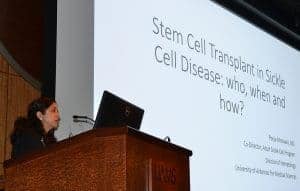Symposium Focuses on Bone Marrow Transplants for Sickle Cell
| Oct. 27, 2017 | At the end of the Sickle Cell Symposium on Oct. 19 at UAMS, a young woman at a microphone during a question-and-answer session boiled the evening’s presentations down to one question: “I haven’t heard the word ‘cure’ used much tonight. Can you call this a cure?”
Pooja Motwani, M.D., said, “Yes, you absolutely can use the word ‘cure.’ You can.”
One of 59 who attended the symposium, the questioner was specifically asking Motwani about the promise of half-match bone marrow transplants for curing sickle cell disease, the symposium’s focus.

Motwani. second from left, and Yarkony, third from left, talk with attendees at the symposium after the formal presentations had concluded.
Motwani, co-director of UAMS Adult Sickle Cell Clinical Program, was the second of two speakers at the program, and her presentation was titled “Stem Cell Transplant as a Cure for Sickle Cell Disease: Who, When and How?” She followed keynote speaker Kathryn Yarkony, Ph.D., A.P.R.N., who gave an overview of the bone marrow transplant program at Johns Hopkins University in Baltimore where she is the lead transplant coordinator.
Bone marrow transplants are one of the procedures used to restore stem cells. Recent advances in ‘half-matched’ bone marrow transplantation have allowed for a much broader range of donors, allowing just about any patient to be eligible for the procedure. This means a donor can be found for nearly every patient who needs a bone marrow transplant to be cured, even if the match isn’t exactly the same.
“The transplant center at Johns Hopkins has one of the best, if not the best, when we talk about outcomes for patients for transplant, pediatric and adult transplants,” Motwani said. “They have very little mortality and very few instances of graft-versus-host disease with their current regimen.”
Graft-versus-host disease occurs when a recipient’s body accepts the new bone marrow but begins attacking the recipient’s own cells.
Yarkony said Johns Hopkins has done transplants for 55 patients — two-thirds were sickle cell patients. More than 90 percent of those sickle cell patients have had new bone marrow cells successfully grafted into their bone marrow. Once the new bone marrow cells take hold, she said, the new cells start producing a new immune system and new red blood cells in the patients. These red blood cells are healthy and do not cause sickling.
While the process cannot reverse some of the effects of the disease, it can stop its progression and just as importantly, successful transplant patients no longer experience the pain crises that disrupt their lives, often result in disability and send them into emergency departments and the hospital, Yarkony said.
Both Yarkony and Motwani said there are some risks with bone marrow transplantation. The chemotherapy used prior to implantation to wipe out a patient’s bone marrow to make room for the new cells can result in infertility and often produces temporary side effects like hair loss, severe fatigue and nausea.
Obstacles to receiving the treatment include the need for pharmacy coverage, insurance and housing while at Johns Hopkins. Transplant there requires a stay of two to three months and the constant presence of a caregiver.
Clinical social workers are ready to work with transplant patients on finding grants and other sources to help finance the procedure, Yarkony said.
Motwani said the half-match has greatly increased the options for sickle cell patients, but there are 47 clinical trials around the country being done at various centers where stem cell transplants are being used as a strategy to cure sickle cell disease.

